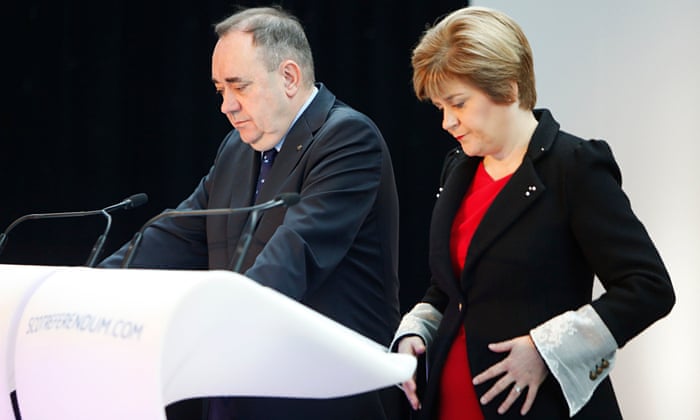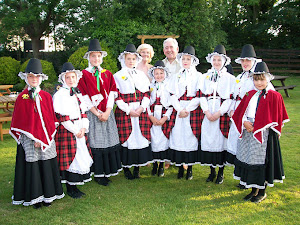SNP publishes draft of first constitution for an independent Scotland
Deputy first minister Nicola Sturgeon releases online document enshrining terms of sovereignty of Scottish people, with Queen as head of state
• Read the draft Scottish constitution
• Read the draft Scottish constitution

A draft of the first constitution for an independent Scotland, legally asserting the sovereignty of the Scottish people but with the Queen as head of state, has been published by the SNP administration in Edinburgh.
The constitution commits the country to enshrine the European convention on human rights in law, tackle climate change and ensure the safe, "expeditious" removal of Trident nuclear weapons.
It would be the first written constitution for any part of the UK. Its opening line is: "In Scotland, the people are sovereign."
The constitution is designed to be a temporary "skeleton" version that would come into force if Scotland becomes independent in March 2016. It was released on Monday by Scotland's deputy first minister, Nicola Sturgeon, for consultation in a draft independence bill.
It confirms that the saltire will continue to serve as the national flag of Scotland and that the choice of national anthem will be made by the Scottish parliament.
The highly symbolic move came as the leaders of the three main pro-UK parties published a rare joint declaration promising that Scots would quickly win significant new tax and welfare powers if they voted no in September's referendum.
With the polls tightening, both sides in the debate are revealing more details about their vision for Scotland after the referendum in the hope of winning round the remaining undecided voters. Sturgeon said the draft bill setting out the constitution was an essential part of the Scottish government's blueprint for independence and would be the first written constitution for any part of the UK.
Britain, unlike other comparable countries, has no codified political system.
"We in the Scottish government are clear that the constitution – with a capital 'C' as it were – is fundamental to, and not different from, the range of issues with which governments deal day in and day out," Sturgeon said in a speech at Edinburgh University.
She said the outline constitution would be a short-term measure, and would be replaced by a full, permanent constitution written by an independent constitutional convention in the years following the first elections, in 2016, after leaving the UK.
Sturgeon said enshrining the sovereign will of the people gave legal meaning to the nationalists' major complaint about the structure of the UK, where parties without a mandate from Scottish voters could make laws which affected them.
She said a full constitution would embody "the values of the nation", secure citizens' rights and provide "a clear distinction between the state and the government of the day, and guarantees a relationship of respect and trust between the institutions of the nation and its people".
The document also promises to:
• protect and enhance the environment;
• take particular account of the needs of Scottish islands;
• observe international law in its foreign policy;
• give citizenship to anyone "habitually resident in Scotland and with a UK passport, or to the children of Scottish citizens;
• and guarantee to safeguard and support the wellbeing of children, defined as those under 18.
The leaders of the pro-UK parties in Scotland – Johann Lamont of Labour, Ruth Davidson of the Tories and the Lib Dem Willie Rennie – made their announcement from Calton Hill overlooking the Scottish government's headquarters in Edinburgh. Their joint statement echoed the draft constitution's reference to popular sovereignty in its opening line: "Power lies with the Scottish people and we believe it is for the Scottish people to decide how we are governed."
The three parties have all made pledges to give the Holyrood parliament greater powers over income tax, housing benefit and other minor benefits, but will not agree a specific joint proposal until they have put their different plans to voters at the 2015 UK general election.
Environment, anti-nuclear and constitutional reform campaigners welcomed the draft constitution because it gave voters more certainty about life after a yes vote, but warned it still left significant and unexpected loopholes.
However, the document fails to enact measures promised by ministers, including ruling out further nuclear power stations in Scotland, or to propose concrete steps to cut climate emissions. It rules out Scotland having a new supreme court – giving the current judiciary greater power to set and decide law, and does not promise to veto using nuclear weapons in Nato.
It also confirms repeatedly that Scottish law is subject to the European courts and international law. It does not set out any new or special protections for religious faiths beyond a general right to equality.
The Scottish government had originally ruled out publishing a draft constitution until after a yes vote and the 2016 Scottish election, to avoid complex and divisive disputes between different interest groups and lawyers.
But, with opinion polls suggesting the race is now tightening, the yes campaign is now driving hard to win centre-left votes and believes a promised constitution could influence wavering voters.
Elliot Bulmer, of the International Institute for Democracy and Electoral Assistance, who previously wrote a draft Scottish constitution which heavily influenced Scottish ministers, said the proposals for drawing up a permanent constitution were too open-ended, with no target date for it to be in place.
He warned that it failed to close a loophole where the monarch could still technically refuse to sign off a contentious bill, or set clear rules on how it could be changed or scrapped. He said: "This would have been the perfect opportunity to close loopholes like can the Queen refuse to assent to legislation? If we're doing this from scratch, why wouldn't you take the opportunity to fix these things?"


























































No comments:
Post a Comment